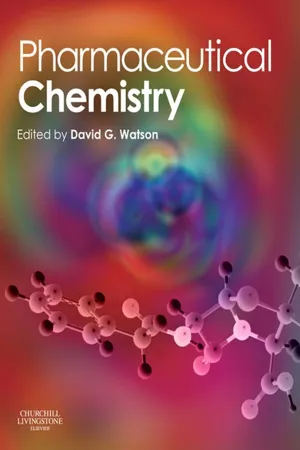
- 652 pages
- English
- ePUB (mobile friendly)
- Available on iOS & Android
Pharmaceutical Chemistry E-Book
About This Book
This new book, from the editor of the highly successful Pharmaceutical Analysis, sets out to define the area of pharmaceutical chemistry as distinct from medicinal chemistry. It focuses less on prototypes of drugs that perhaps never came to market and more on the drugs currently in use. The emphasis in the book is on the physicochemical properties of drug molecules and, in so far as they are known, the way that these properties govern the interaction of the drug with its target. Important physicochemical properties include pKa and partition coefficient and the properties of the structural elements within the drug which provide interactions with the target via a range of intermolecular forces. The last fifteen years has seen a great advance in the knowledge of protein structures and a strong emphasis is given to the interaction of drugs with proteins which shape the majority of drug mechanisms.
Features:
- Focus on intramolecular actions
- Mechanisms of action richly illustrated
- Self-assessment included
- Comprehensive chapters on vitamins and biotechnological products
This new book, from the editor of the highly successful Pharmaceutical Analysis, sets out to define the area of pharmaceutical chemistry as distinct from medicinal chemistry. It focuses less on prototypes of drugs that perhaps never came to market and more on the drugs currently in use. The emphasis in the book is on the physicochemical properties of drug molecules and, in so far as they are known, the way that these properties govern the interaction of the drug with its target. Important physicochemical properties include pKa and partition coefficient and the properties of the structural elements within the drug which provide interactions with the target via a range of intermolecular forces. The last fifteen years has seen a great advance in the knowledge of protein structures and a strong emphasis is given to the interaction of drugs with proteins which shape the majority of drug mechanisms.
Features:
- Focus on intramolecular actions
- Mechanisms of action richly illustrated
- Self-assessment included
- Comprehensive chapters on vitamins and biotechnological products
Frequently asked questions
Information
Table of contents
- Cover
- Title Page
- Front matter
- Copyright
- Preface
- Contributors
- Table of Contents
- Chapter 1: Bond type and bond strength
- Chapter 2: Hydrocarbons: alkanes, alkenes, aromatic and alkylhalides
- Chapter 3: Amines
- Chapter 4: Neutral and acidic nitrogen compounds
- Chapter 5: Oxygen- and sulphur-containing functional groups
- Chapter 6: Protein structure and its relevance to drug action
- Chapter 7: DNA structure and its importance to drug action
- Chapter 8: Drug absorption, distribution, metabolism and excretion
- Chapter 9: Structure, activity and drug design
- Chapter 10: Drugs affecting the adrenergic system
- Chapter 11: Drugs exerting non-adrenergic effects on cardiac output and vascular tone
- Chapter 12: Drugs interacting with mammalian enzymes
- Chapter 13: Central nervous system depressants
- Chapter 14: Analgesics
- Chapter 15: Local anaesthetics
- Chapter 16: Anticholinergic agents
- Chapter 17: Antihistamine drugs
- Chapter 18: CNS stimulants and CNS-active drugs affecting the serotonergic system
- Chapter 19: Drugs affecting haemostasis and thrombosis
- Chapter 20: Drugs affecting the endocrine system
- Chapter 21: Anticancer drugs
- Chapter 22: Antimicrobial chemotherapy
- Chapter 23: Antiviral drugs
- Chapter 24: Antifungal chemotherapy
- Chapter 25: Antiparasitic drugs
- Chapter 26: Vitamins and minerals
- Chapter 27: Biotechnologically produced products
- Chapter 28: Drug and gene delivery systems
- Chapter 29: The tonic and toxic effects of alcohol and its metabolites
- Index